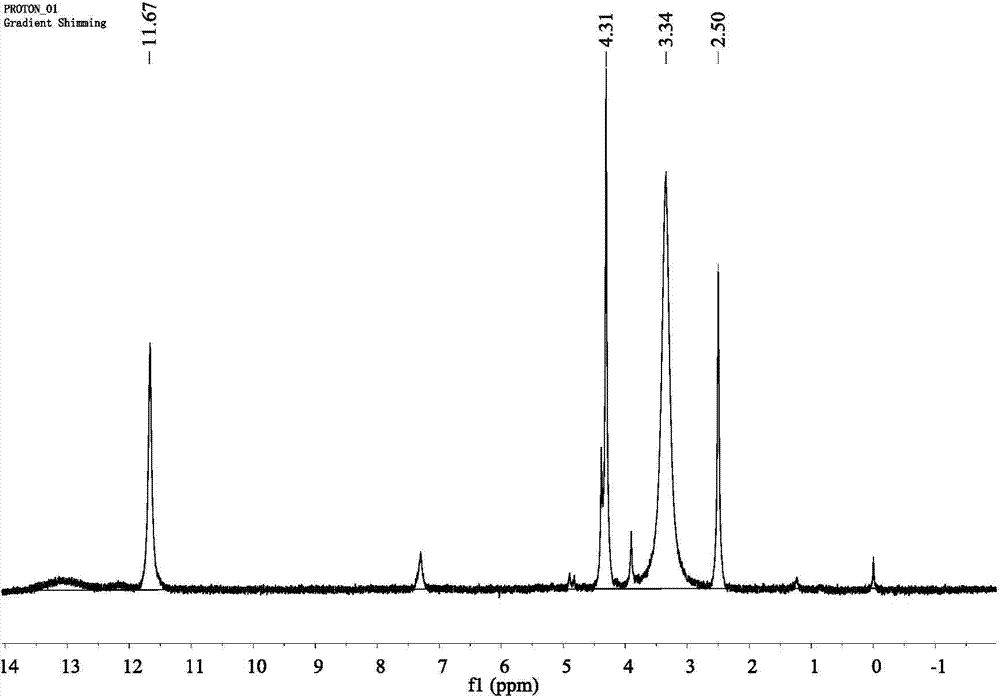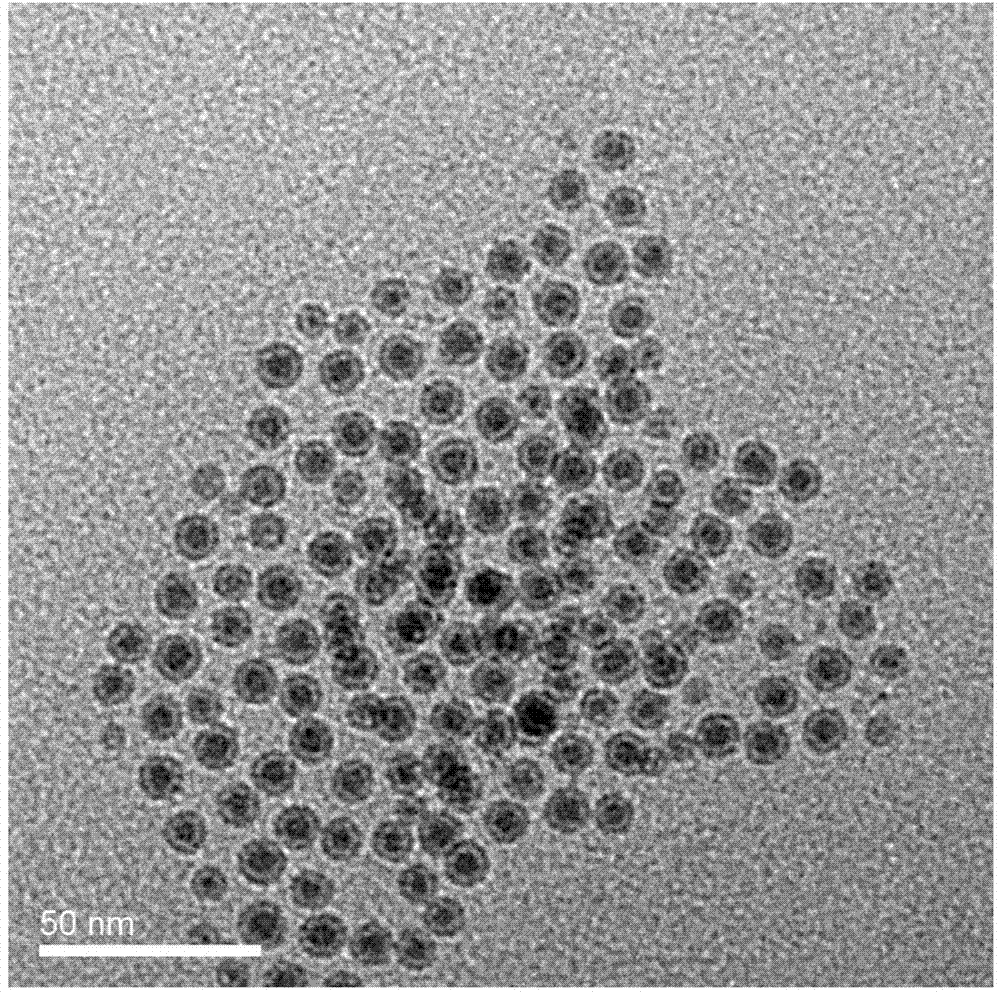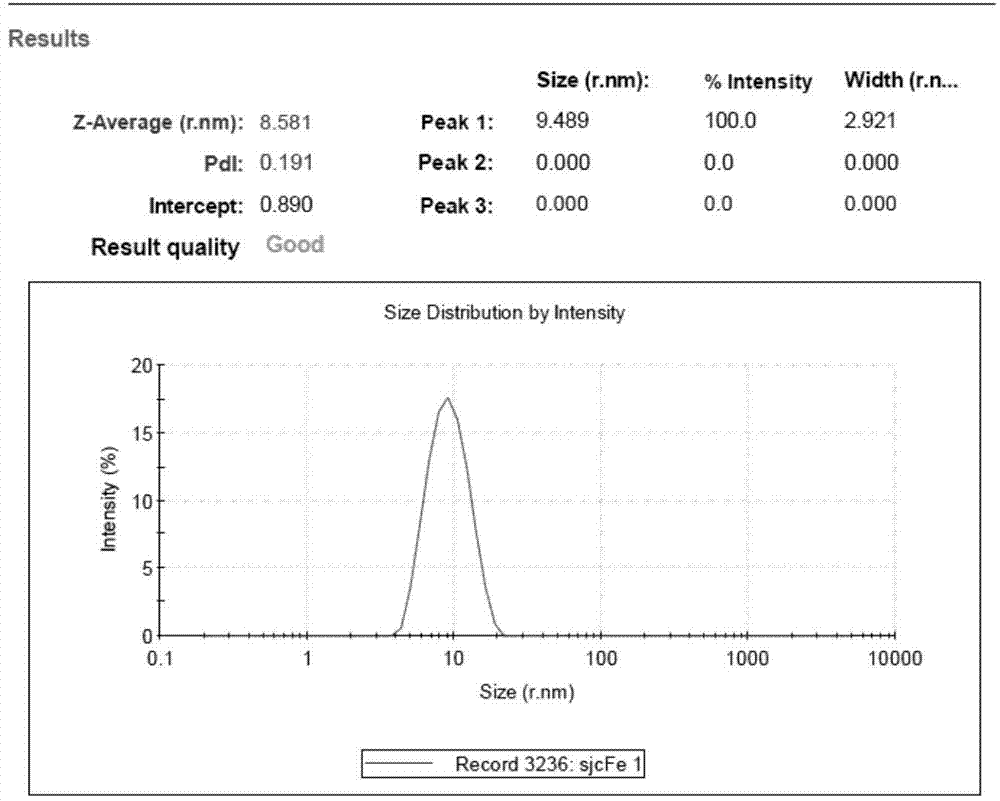Nuclear magnetic resonance sensor for detecting melamine based on magnetic nanoparticles, and preparation method and application thereof
A technology of magnetic nanoparticles and melamine, applied in nuclear magnetic resonance analysis, nuclear magnetic resonance/magnetic resonance imaging contrast agents, etc., can solve problems such as urine can not be successfully discharged, renal tubular obstruction, renal failure, etc., and the preparation method is simple Safety, economy of raw materials, effect of enriching the research field
- Summary
- Abstract
- Description
- Claims
- Application Information
AI Technical Summary
Problems solved by technology
Method used
Image
Examples
Embodiment 1
[0031] (1) Add 5.0g of cyanuric acid to 150mL of dry DMF, then add 1.15mL of DBU, 1.2mL of benzyl bromoacetate, stir at room temperature for 1h under Ar atmosphere, then heat to 70°C and keep for more than 12h, After the reaction was finished, cool to room temperature, remove DMF by distillation under reduced pressure, the obtained solid was washed and filtered with THF, the obtained filtrate was concentrated, washed with cold water, filtered and dried, and the obtained solid was analyzed by column chromatography (SiO 2 , CH 2 Cl 2 / MeOH, 24:1) separation and purification to obtain white solid benzyl ester.
[0032] (2) Dissolve 477mg NaOH in 15mL H 2 O, mix well, add 661mg benzyl ester, stir overnight at room temperature, after the reaction, acidify with 36wt% HCl, pH = 1, remove H by distillation under reduced pressure 2 O, the obtained substance was extracted several times by THF filtration, and the filtrate was concentrated to obtain a white solid specific receptor unit...
Embodiment 2
[0035] Take 20mL of octadecene with a measuring cylinder, 0.2mL of oleylamine with a pipette, and 0.1g of HDA·HCl with an analytical balance, add them into a three-necked flask, mix well, stir magnetically and remove the air, and the time is controlled at about 1h. The temperature was raised to 120°C and kept for 30 minutes. heated to 180°C with N 2 Gas protection, rapid injection of 0.7mL Fe(CO) 5 , maintaining the stirring speed at maximum. After keeping at 180°C for 20 minutes, inject oleic acid (0.3 mL, 1 mmol) and keep it for 10 minutes. Remove heat source, cool to room temperature, and expose to air. Centrifuge (12000rpm, 10min) until washed. Obtained Fe / Fe 3 o 4 Nanoparticles are dispersed in n-hexane.
[0036] The TEM figure of the magnetic nanoparticles prepared in this embodiment is as follows figure 2 shown; DLS as image 3 Shown; X-ray diffraction pattern as Figure 4 Shown; Infrared spectrum as Figure 5 shown.
Embodiment 3
[0038] (1) Analytical balance Weigh the acceptor unit (m=16.84mg, M=187.11g / mol, n=0.09mmol) and dissolve it in 5mL of pyridine, add 25mg of N-hydroxysuccinimide, and react for 1h to obtain solution A ; Dissolve polyethylene glycol monocarboxylic acid (m=60mg, M=2000g / mol, n=0.03mmol) in 5mL of pyridine with an analytical balance, add 10mg of N-hydroxysuccinimide, and react for 1h to obtain solution B .
[0039] (2) Analytical balance weighs Dopa-HCl (m=15.2mg, M=189.68g / mol, n=0.08mmol), 1-ethyl-(3-dimethylaminopropyl) carbodiimide hydrochloride Dissolve 25 mg of salt in 1 mL of chloroform, and disperse evenly with ultrasonic waves to obtain solution A'; weigh Dopa-HCl (m=4 mg, M=189.68 g / mol, n=0.02 mmol), 1-ethyl-(3 - 10 mg of dimethylaminopropyl) carbodiimide hydrochloride was dissolved in 1 mL of chloroform, and ultrasonically dispersed to obtain solution B'; solution A' was added to solution A, and solution B' was added to solution B.
[0040] (3) Stir magnetically for...
PUM
| Property | Measurement | Unit |
|---|---|---|
| Particle size | aaaaa | aaaaa |
Abstract
Description
Claims
Application Information
 Login to View More
Login to View More - R&D
- Intellectual Property
- Life Sciences
- Materials
- Tech Scout
- Unparalleled Data Quality
- Higher Quality Content
- 60% Fewer Hallucinations
Browse by: Latest US Patents, China's latest patents, Technical Efficacy Thesaurus, Application Domain, Technology Topic, Popular Technical Reports.
© 2025 PatSnap. All rights reserved.Legal|Privacy policy|Modern Slavery Act Transparency Statement|Sitemap|About US| Contact US: help@patsnap.com



